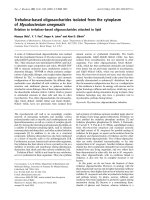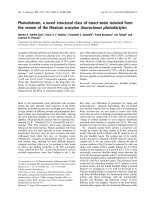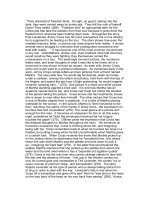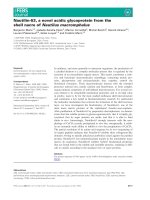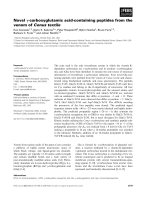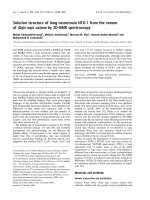A novel protein isolated from the venom of ophiophagus hannah (king cobra) showing beta blocker activity
Bạn đang xem bản rút gọn của tài liệu. Xem và tải ngay bản đầy đủ của tài liệu tại đây (7.99 MB, 246 trang )
β-CARDIOTOXIN: A NOVEL PROTEIN ISOLATED FROM THE
VENOM OF OPHIOPHAGUS HANNAH
(KING COBRA)
SHOWING BETA-BLOCKER ACTIVITY
NANDHAKISHORE RAJAGOPALAN
(M. Sc. (Life Sciences))
A THESIS SUBMITTED FOR THE DEGREE OF
DOCTOR OF PHILOSOPHY AT THE
NATIONAL UNIVERSITY OF SINGAPORE
DEPARTMENT OF BIOLOGICAL SCIENCES, FACULTY
OF SCIENCE, NATIONAL UNIVERSITY OF SINGAPORE
JANUARY, 2008
Wxw|vtàxw àÉ Åç ytÅ|Äç
tÇw
àxtv{xÜá
ii
iii
ACKNOWLEDGEMENTS
I would like to thank my supervisor Professor R Manjunatha Kini for his constant
encouragement throughout my stay in Singapore. He provided me an opportunity
to work in his lab as a visiting student from January to December 2003. He
encouraged me to join the graduate program at NUS, which, I consider as a
turning point in my life. What I really like about his management is the freedom
he has given me in thinking and designing my work. This has molded me as an
independent researcher over the past few years.
Next, I would like to thank my co-supervisor Associate Professor Prakash Kumar.
He has been a pillar of support throughout my time in Singapore. His useful
suggestions during the manuscript preparation are not only reflected in the
published article but will also influence the way I write in future.
I would like to thank the graduate program run by the National University of
Singapore for their financial support. I would also like to thank the Biomedical
Research Council (BMRC) for their grant which funded the research.
All this work would not have been possible without the support of our able
collaborators. I would like to thank Associate Professor Peter Wong for helping
me out whenever I had some experiments to be done at the Department of
Pharmacology. I would also like to thank Dr. Zhu Yi Zhun for opening the doors
of his lab for my work. I would like to thank the staff and students from the
Department of Pharmacology for their technical support. Thanks to Assistant
Professor Bian Jinsong, Dr. Wong Zong Jing, Mrs. Ting Wee Lee, Ms. Pei Ling,
Ms. Kay Lee and Ms. Ning Li. I would also like to thank Assistant Professor
Jayaraman Shivaraman and Ms. Sunita for their kind support for the structural
studies.
I would like to thank all the teachers who made a difference in my life. I would
like to thank Mrs. Radha, Mrs. Meera, Mrs. Vijayalakshmi, Mrs. Saraswathi
iv
Chandrasekaran, Dr. Akbar Sha, Dr. M. Krishnan, Dr. A. S. Rao and Dr. Chellam
Balasundaram.
I would like to express my gratitude to my seniors Dr. Selvanayagam Nirthanan
(Niru) and Dr. Rajamani Lakshminarayanan (Lakshmi) for their valuable
suggestions and constant motivation.
I would like to thank all my lab mates for making my stay fun and entertaining.
Thanks to Dr. Pung Yuh Fen, for guidance during my stint as a trainee, Dr.
Yajnavalka Banerjee, for providing great support and guidance, Dr. Md Abu Reza,
Dr. Dileep Gangadharan, Dr. Syed Rehana, Dr. Joanna Pawlak, Dr. Kang Tse
Siang, Rocky, Shifali and Dr. Raghurama Hegde for all the help they have done. I
would like to thank Cho Yeow and Shi Yang for organizing great lab parties and
Dr. Robin Doley for managing the complicated finances for these parties. I would
like to thank Amrita and Girish for keeping me highly entertained during the
writing of the thesis. I would also like to thank the “Kids Army” (a.k.a the
undergrads) members Sin Min, Ee Xuan, Ming Zhi, Bee Har and Maulana for
spreading their infectious enthusiasm. Last but not the least I would like to thank
Ms. Tay Bee Ling for maintaining the lab finances and making sure we get things
on time.
I am grateful to my family for their support. Thanks to my father Mr. Rajagopalan
and my mother Mrs. Lalitha Rajagopalan, my brothers Mr. Prasanna and Mr.
Vasanth and my cousins Ms. Aarthi Ravichandran and Ms. Madhulika
Ravichandran.
Nandhakishore Rajagopalan
January, 2008
v
TABLE OF CONTENTS
Page
Dedication ii
Acknowledgements iv
Table of contents vi
Summary xii
Research collaborations xiv
Acknowledgement of copyright xv
Photo courtesy xvi
List of figures xvii
List of tables xx
Abbreviations xxi
CHAPTER ONE: INTRODUCTION 1
1.1 VENOMOUS SNAKES 2
1.1.1 Classification of venomous snakes 4
1.1.2 Ophiophagus hannah 7
1.2 SNAKE VENOMS 10
1.2.1 Classification of venom proteins 10
1.2.1.1 Enzymatic proteins 10
1.2.1.2 Non-enzymatic proteins 13
1.3 THE THREE-FINGER TOXIN FAMILY 14
1.3.1 Neurotoxins 16
1.3.2 Non-conventional toxins 19
1.3.3 Muscarinic toxins 22
1.3.4 Fasciculins 23
1.3.5 Cardiotoxins 26
1.3.6 Calciseptine and FS
2
toxin 29
1.3.7 Dendroaspin or mambin 31
1.3.8 Hannalgesin 33
1.3.9 3FTXs from Colubridae snakes 33
vi
1.3.10 3FTXs from Viperidae snakes 36
1.3.11 3FTXs as dual functional molecules 36
1.3.12 The 3FTX fold in non-venom proteins 37
1.3.13 The three-finger fold: ‘leprechauns
1
’ of molecular
interactions 37
1.4 THE G PROTEIN-COUPLED RECEPTORS 44
1.4.1 General organization of GPCRs 45
1.4.2 The β-adrenergic signaling pathway 50
1.4.2.1 β
1
-AR signaling 52
1.4.2.2 β
2
-AR signaling 53
1.4.2.3 β
3
-AR signaling 56
1.4.3 Structures of β
2
-adrenergic receptor 56
1.5 AIM AND SCOPE OF THE THESIS 65
CHAPTER TWO: IDENTIFICATION AND ISOLATION OF β-
CARDIOTOXIN 67
2.1 INTRODUCTION 68
2.2 MATERIALS AND METHODS 70
2.2.1 Reagents and kits 70
2.2.2 O. hannah venom glands 70
2.2.3 Isolation of total RNA 70
2.2.4 Construction of cDNA library using 5’-RACE ready
cDNA 71
2.2.5 TA-cloning 71
2.2.6 Preparation of E. coli DH5α competent cells 72
2.2.7 Heat-shock transformation 72
2.2.8 Isolation of plasmid DNA 73
2.2.9 Verification of clones using restriction digestion 74
2.2.10 DNA sequencing and analysis 74
2.2.11 O. hannah venom 74
2.2.12 Chemicals and columns 75
2.2.13 Isolation of novel proteins 75
vii
2.2.14 Molecular mass determination 75
2.2.15 N-terminal sequencing 76
2.2.16 Circular dichroism (CD) spectra 76
2.3 RESULTS 78
2.3.1 Construction of O. hannah venom gland cDNA library 78
2.3.2 Identification of novel proteins 78
2.3.3 Isolation and characterization of novel proteins 83
2.3.4 CD spectra of novel proteins 86
2.4 DISCUSSION 90
2.4.1 Identification and isolation of novel proteins from
O. hannah venom 90
2.4.2 Identification of unique secondary structural
conformation of β-cardiotoxin 93
2.5 CONCLUSIONS 96
CHAPTER THREE: MECHANISM OF ACTION OF
β-CARDIOTOXIN 97
3.1 INTRODUCTION 98
3.2 MATERIALS AND METHODS 101
3.2.1 Animals 101
3.2.2 Methods of protein administration 101
3.2.3 In vivo toxicity study 102
3.2.4 Anticoagulant activity 102
3.2.4.1 Prothrombin time 102
3.2.4.2 Recalcification time 102
3.2.5 Hemolytic assay 103
3.2.6 ECG monitoring and heart rate determination 103
3.2.7 Isolated perfused heart 104
3.2.8 Measurement of isovolumetric cardiac performance 105
3.2.9 Competitive binding assay 105
3.3 RESULTS 107
3.3.1 In vivo toxicity study 107
viii
3.3.2 Anticoagulant activity 107
3.3.3 Hemolytic activity 108
3.3.4 Cardiac effects of β-cardiotoxin 108
3.3.5 Isolated perfused heart studies 112
3.3.6 Competitive binding assays 112
3.4 DISCUSSION 117
3.4.1 β-Cardiotoxin belongs to a new class of 3FTXs 118
3.5 CONCLUSIONS 121
CHAPTER FOUR: CHARACTERIZATION OF A MOLTEN
GLOBULE INTERMEDIATE OF β-CARDIOTOXIN 122
4.1 INTRODUCTION 123
4.2 MATERIALS AND METHODS 124
4.2.1 Proteins and reagents 124
4.2.2 Thermal denaturation studies using CD spectroscopy 124
4.2.3 Chemical denaturation studies using CD spectroscopy 125
4.2.4 Effect of pH on secondary structure 125
4.2.5 Combined effects of pH and temperature on
β-cardiotoxin structure 125
4.3 RESULTS 126
4.3.1 Thermal denaturation studies 126
4.3.2 Chemical denaturation studies 130
4.3.3 Effect of pH on secondary structure 130
4.3.4 Combined effects of pH and temperature on
β-cardiotoxin structure 133
4.4 DISCUSSION 137
4.4.1 Identification of a unique α-helical ‘molten globule’
intermediate 137
4.5 CONCLUSIONS 142
CHAPTER FIVE: STRUCTURAL CHARACTERIZATION AND
STRUCTURE-FUNCTION RELATIONSHIPS OF
ix
β-CARDIOTOXIN 143
5.1 INTRODUCTION 144
5.2 MATERIALS AND METHODS 145
5.2.1 Proteins and reagents 145
5.2.2 Crystallization of β-cardiotoxin 145
5.2.3 Data collection 146
5.2.4 Peptide synthesis 146
5.2.5 Purification of synthetic peptides 146
5.2.6 Mass determination 147
5.2.7 Air oxidation of peptides 147
5.2.8 Competitive binding assays 147
5.3 RESULTS 148
5.3.1 Crystallization of β-cardiotoxin 148
5.3.2 Synthesis and purification of peptides 148
5.3.3 Competitive binding assays 153
5.4 DISCUSSION 157
5.4.1 Crystallization of β-cardiotoxin 157
5.4.2 Structure-function relationships of β-cardiotoxin 157
5.5 CONCLUSIONS 160
CHAPTER SIX: CONCLUSIONS AND FUTURE PERSPECTIVES 161
6.1 GENERAL CONCLUSIONS 162
6.2 FUTURE PERSPECTIVES 165
6.2.1 3-Dimensional structure of β-cardiotoxin 165
6.2.2 Site-directed mutagenesis studies to determine the
functional site 165
6.2.3 Characterization of the α-helical ‘molten globule’
intermediate 166
6.2.4 Nature of antagonism of β-cardiotoxin 166
6.2.5 Developing shorter bioactive peptides 166
6.2.6 Characterization of other novel proteins identified
from the cDNA library 167
x
Bibliography 168
Appendix 190
Publications 197
xi
SUMMARY
Snake venoms have provided a number of novel ligands with therapeutic potential.
These proteins have been classified into a small number of super-families that
may be enzymatic or non-enzymatic. In the past, the most abundant or the most
active proteins from the snake venoms have been well characterized. In recent
times many new and less abundant molecules from snake venoms have been
isolated and characterized by employing more sophisticated techniques from
proteomics and genomics.
We have constructed a cDNA library from the venom gland mRNA of
Ophiophagus hannah (king cobra) and identified five novel proteins. From the
Cys numbers and pattern we concluded that all these new proteins belong to the
three-finger toxin family of snake venom proteins. We have isolated one of these
proteins with a mass of 7012.43 ± 0.91 Da from the venom using a two-step
chromatography approach with size-exclusion chromatography as the first step
and reverse phase high performance liquid chromatography as the second one.
This protein was non-lethal in mice up to an intra-peritoneal dose of 10 mg/kg. It
is also non-hemolytic and does not show anti-coagulant activity. It caused a
decrease of heart rate in anesthetized rats as well as in rat isolated perfused heart,
in contrast to conventional cardiotoxins that increase the heart rate. Radioligand
displacement studies showed that this protein targets β-adrenergic receptors with a
K
i
of 5.3 and 2.3 µM toward human β
1
and β
2
subtypes, respectively, and hence
xii
we named the protein as β-cardiotoxin. This is the first report of an exogenous
protein beta-blocker.
We have identified a ‘molten globule’ intermediate in the thermal unfolding
pathway and characterized it using CD spectroscopy. β-Cardiotoxin undergoes a
structural transition from β-sheet to α-helix at higher temperatures. This α-helical
intermediate does not occur in the chemical denaturation of the protein. We have
also identified and optimized a condition for obtaining diffraction quality crystals
of β-cardiotoxin.
Finally, we have initiated structure-function relationship studies for identifying
the functional site of the protein. This information along with the 3-D structure of
the protein will enable us to design novel bioactive peptides with therapeutic
potential for treatment of cardiovascular diseases.
xiii
RESEARCH COLLABORATIONS
The following laboratories provided invaluable technical assistance in performing
some of the experiments discussed in this thesis. Their contribution is gratefully
acknowledged.
• Associate Professor Peter Tsun Hon Wong and Mrs. Ting Wee Lee.
Department of Pharmacology, Yong Loo Lin School of Medicine,
National University of Singapore.
• Associate Professor Zhu Yi Zhun, Dr. Wang Zong Jing, Ms. Ho Pei Ying
and Ms. Ning Li. Department of Pharmacology, Yong Loo Lin School of
Medicine, National University of Singapore.
• Assistant Professor Jayaraman Shivaraman, Ms. Sunita, Dr.
Sundaramurthy Kumar and Mr. Jobichen Chako. Structural Biology
Laboratories, Department of Biological Sciences, National University of
Singapore.
xiv
ACKNOWLEDGEMENT OF COPYRIGHT
o Dr. Robert A. Barish MD, Vice dean for Clinical Affairs, University of
Maryland School of Medicine, USA for permission to reproduce Figure
1.1 and Table 1.1 in Chapter 1.
o Professor R Manjunatha Kini, Department of Biological Sciences,
National University of Singapore for permission to reproduce Figure 1.4 in
Chapter 1 and Figure A.5 in Appendix.
o Professor Miyano Masashi, Chief Scientist and Head, Structural
Biophysics Laboratory RIKEN SPring-8 Center, Japan for permission to
reproduce Figure 1.14 in Chapter 1 and for kindly providing Figure 1.20 in
Chapter 1.
o Professor Brian Kobilka, Department of molecular and cellular physiology,
Stanford University School of Medicine, USA for permission to reproduce
Figure 1.15, 1.16, 1.21, 1.22 and 1.23 in Chapter 1 and Figure 5.3 in
Chapter 5.
o Professor Raymond C. Stevens, Departments of Molecular Biology,
Chemistry, The Scripps Research Institute, USA for permission to
reproduce Figure 1.21, 1.22 and 1.23 in Chapter 1.
o Dr. Howard Rockman, MD, Professor of Medicine, Cell Biology and
Molecular Genetics, Chief of Cardiology, Duke University Medical Center,
USA for permission to reproduce Figure 1.17, 1.18 and 1.19 in Chapter 1.
o Professor Stephen Sprang, Director, Center for Biomolecular Structure and
Dynamics and Professor, Division of Biological Sciences, University of
Montana, USA for permission to reproduce Figure 1.24 in Chapter 1.
xv
PHOTO COURTESY
¾ Mr. Shiyang Kwong, National University of Singapore, Singapore for
kindly providing photo of Bitis gabonica (Gaboon viper) for Figure 1.2 in
Chapter 1.
¾ Mr. Duncan MacRae Phyto Medichem Singapore Pte. Ltd for kindly
providing photo of Ophiophagus hannah (King cobra) for Figure 1.2 in
Chapter 1.
¾ Ms. Susan Scott for kindly providing photo of Pelamis platurus (Yellow-
bellied sea snake) for Figure 1.2 in Chapter 1.
¾ Mr. Peter Mirtschin, Venom Supplies Pte. Ltd., Australia for kindly
providing photo of Ophiophagus hannah (King cobra) for Figure 1.3 in
Chapter 1.
xvi
LIST OF FIGURES
PAGE
Chapter One
Figure 1.1 Venom gland and venom delivery apparatus 3
Figure 1.2 Venomous snakes from different families 6
Figure 1.3 Ophiophagus hannah (King cobra) 8
Figure 1.4 Structural similarities between ‘sibling’ three-finger toxins 15
Figure 1.5 α-neurotoxins 17
Figure 1.6 Non-conventional toxins 20
Figure 1.7 Muscarinic toxins 24
Figure 1.8 Fasciculins 25
Figure 1.9 Cardiotoxins 27
Figure 1.10 Calciseptine and FS2 toxins 30
Figure 1.11 Dendroaspin or mambin 32
Figure 1.12 3FTXs from Colubridae venoms 34
Figure 1.13 Non-venom proteins with the three-finger fold 38
Figure 1.14 Two-dimensional model of bovine rhodopsin 46
Figure 1.15 Schematic structure of β
2
-AR 47
Figure 1.16 The secondary structure and location of agonist binding
sites for different GPCRs 49
Figure 1.17 Overview of GPCR signaling 51
Figure 1.18 G
s
coupled receptor signaling 54
Figure 1.19 G
i
coupled receptor signaling 55
Figure 1.20 Ribbon drawings of inactive bovine rhodopsin 57
Figure 1.21 Comparison of crystal structures of β
2
-AR-T4L fusion
protein and the complex between β
2
-AR365 and a Fab
fragment 59
Figure 1.22 Comparison of β
2
-AR-T4L transmembrane helices with
rhodopsin 60
Figure 1.23 Interactions of the “ionic lock” formed by the
xvii
conserved E(D)RY motif 62
Figure 1.24 Cartoon representation of the β
2
-AR structure 63
Chapter Two
Figure 2.1 Construction of cDNA library 79
Figure 2.2 Abundance of various genes from cDNA library 81
Figure 2.3 Multiple sequence alignment of novel proteins 82
Figure 2.4 Gel filtration of O. hannah venom 84
Figure 2.5 Purification of β-cardiotoxin 84
Figure 2.6 ESI-MS of β-cardiotoxin 85
Figure 2.7 Purification of WTX DE1 homolog 1 and MTLP-3
homolog 87
Figure 2.8 Comparison of secondary structure of β-cardiotoxin
with conventional CTXs 88
Figure 2.9 Far-UV CD spectrum of WTX DE1 homolog 1 89
Figure 2.10 Far-UV CD spectrum of MTLP-3 homolog 89
Figure 2.11 Changes in residues between β- cardiotoxin and its
isoforms from O. hannah venom 92
Chapter Three
Figure 3.1 Substitutions in the loop regions of β-cardiotoxin 99
Figure 3.2 Effect of β-cardiotoxin on blood coagulation 109
Figure 3.3 Hemolytic activities of β-cardiotoxin and CM18 109
Figure 3.4 Effects of β-cardiotoxin on cardiac function 110
Figure 3.5 Induction of bradycardia by β-cardiotoxin 111
Figure 3.6 Effects of β-cardiotoxin on Langendorff perfused hearts 113
Figure 3.7 Changes in heart rate after treatment with β-cardiotoxin 114
Figure 3.8 Interaction of β-cardiotoxin with β-ARs 116
Chapter Four
Figure 4.1 Effect of temperature on the secondary structure of
conventional CTX CM18 127
xviii
Figure 4.2 Effect of temperature on the secondary structure of
β-cardiotoxin 128
Figure 4.3 Refolding of CM18 and β-cardiotoxin after thermal
denaturation 129
Figure 4.4 Effect of temperature on tertiary structure of
β-cardiotoxin 131
Figure 4.5 Chemical denaturation of β-cardiotoxin 132
Figure 4.6 Effect of pH on the secondary structure of β-cardiotoxin 134
Figure 4.7 Combined effects of temperature and pH on the
secondary structure of β-cardiotoxin 135
Figure 4.8 Combined effects of temperature and pH on the
tertiary structure of β-cardiotoxin 136
Figure 4.9 Prediction of secondary structure of β-cardiotoxin 140
Chapter Five
Figure 5.1 Crystals of β-cardiotoxin 149
Figure 5.2 X-ray diffraction pattern 150
Figure 5.3 β
2
-AR ligands 151
Figure 5.4 Design of peptides 152
Figure 5.5 Purification of synthetic peptides 154
Figure 5.6 ESI-MS of purified synthetic peptides 155
Figure 5.7 Interaction of synthetic peptides with β-ARs 156
xix
LIST OF TABLES
PAGE
Chapter One
Table 1.1 Venomous snakes of the world 5
Table 1.2 Enzymatic proteins from snake venoms 11
Table 1.3 Non-enzymatic proteins from snake venoms 12
Table 1.4 Diversity of the three-finger fold 40-42
xx
ABBREVIATIONS
Single letter and three letter abbreviations of amino acid residues were followed
as per the recommendations of the IUPAC-IUBMB Joint Commission on
Biochemical Nomenclature.
Chemicals and reagents
Amp Ampicillin
DIPEA N, N-diisopropylethylamine
DMF N, N-dimethylformamide
dNTP deoxy nucleotide triphosphate
HATU O-(7-azabenzotriazol-1-yl)-1,1,3-3-
tetramethyluronium hexafluorophosphate
IPTG Isopropyl β-D-thiogalactopyranoside
KH Krebs-Henselsit
LB Luria-bertani
MES [2-(N-morpholino) ethanesulfonic acid]
MOPS [3-(N-morpholino) propanesulfonic acid]
PEG Polyethylene glycol
PEG-PS Polyethylene glycol-polystyrene
RT Reverse transcriptase
TFA Trifluoroacetic acid
TFE Trifluoroethanol
UP Universal primer
X-gal 5-bromo-4-chloro-3-indolyl-β-D-galactopyranoside
Units and measurements
°C Degree Celcius
µg Micro gram
µl Micro liter
xxi
µM Micro molar
Å Angstrom
bp Base pair
BPM Beats per minute
cm Centi meter
Da Daltons
g Grams
h Hour
HR Heart rate
K Kelvin
kb Kilo base
kg Kilo gram
l Liter
LVDEP Left ventricle diastolic end pressure
M Molar
mg Milli gram
min Minute
ml Milli liter
mM Milli molar
nM Nano molar
nm Nano meter
rpm Revolutions per minute
s Second
wk Week
Others
3-D Three-dimensional
3FTX Three-finger toxin
7TM Seven transmembrane
AC Adenylyl cyclase
AchE Acetylcholinesterase
AR Adrenergic receptors
xxii
BLAST Basic local alignment search tool
cAMP cyclic monophosphate
CD Circular dichroism
cDNA complementary DNA
CICR Ca
2+
induced Ca
2+
release
CRISP Cycteine-rich secretory protein
CTX Cardiotoxin
CVD Cardiovascular disease
DNA Deoxyribonucleic acid
EBI European bioinformatics institute
ECG Electrocardiogram
ECL Ectracellular loop
ESI-MS Electrospray ionization-mass spectrometry
G Proteins GTP binding proteins
GPCR G protein-coupled receptor
GTP Guanidine triphosphate
i.p. intra peritoneal
i.t.v. intra tail vein
IC Intracellular
IC
50
Dose which causes 50 % inhibitory effect
LAO L-amino acid oxidase
LC/MS Liquid chromatography/mass spectrometry
LD
50
Lethal dose causing death of 50 % of animals tested
LNTX Long neurotoxin
LV Left ventricle
mAChR Muscarinic acetylcholine receptor
mRNA Messenger RNA
MT Muscarinic toxin
MTLP Muscarinic toxin like protein
nAChR Nicotinic acetylcholine receptor
NCBI National center for biotechnology information
NGF Nerve growth factor
xxiii
NMR Nuclear magnetic resonance
NOESY Nuclear Overhauser effect spectroscopy
PCR Polymerase chain reaction
PKA cAMP-dependant protein kinase
PLA
2
Phospholipase A
2
PLC β Phospholipase C β
PLM Phospholamban
PTH Phenylthiohydantion
RACE Rapid amplification of cDNA ends
RBC Red blood cells
REM Rapid eye movement
RGD Arg-Gly-Asp- tripeptide
RNA Ribonucleic acid
RP-HPLC Reverse phase-high performance chromatography
RyR2 Ryanodine receptor
SD Sprague-Dawley
SR Sarcoplasmic reticulum
T4L T4 Lysozyme
TM Transmembrane
TNF-α Tumor necrosis factor-α
UV Ultra violet
WTX Weak toxin
α Alpha
β Beta
β-AR β-adrenergic receptor
β-LG β-Lactoglobulin
γ Gamma
κ Kappa
xxiv
Chapter One
Introduction

